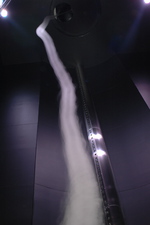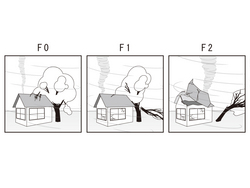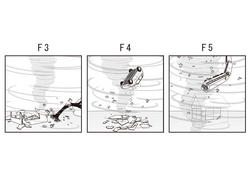Nagoya City Science Museum
TOP > Exhibition Guide > Floor Map> Tornado Lab
Tornado Lab

Purpose of Exhibition
This is an experimental device to create artificial tornadoes.
With a more than 9m high spectacular view over an air vortex, while closely observing, you can understand its characteristics and cultivate scientifically an eye for natural phenomena.


Additional Knowledge
[Unexpectedly Numerous Tornadoes]
A powerful vortex of air under a thunderstorm is a tornado. Tornadoes are frequent in the Midwest of the USA (more than 1000 a year). Although many are small, some large-scale tornadoes cause a lot of damage. Not so many tornadoes occur in Japan; an average of 18 tornadoes occur yearly and sometimes they cause serious damage.
[Mechanism of a tornado]
The mechanism that causes a tornado is not yet fully known.
It will disappear as soon as you think it occurred, the area of generation is narrow, and observation from within the tornado is extremely dangerous, therefore it is very difficult to understand the full picture. However, tornado-prone environments are known to some extent. For a tornado to occur, rotating flow and rising air are required. It has been discovered that a rising vortex (mesocyclone) with some kilometers in diameter develops inside large thunderstorm clouds (super cell). Under the storm, rotating flow is generated by current collision among complex air flow. It is suggested that this mesocyclone's large rising air stretches one of rotating flows produced near the ground and grows to become a tornado.
[Different Shapes of Clouds in Artificial and Natural Tornadoes]
In natural tornadoes, a funnel-shaped cloud, which is developed from a cumulonimbus cloud, can be created. The upper part of the cloud looks wide and the lower part looks narrow. When the upper part is high up, air is decompressed and cloud particles (water droplets) are formed. On the other hand, the "tornado" produced in this experiment looks thin on top. That is because water droplets are generated by an ultrasonic humidifier in the lower part of this device, so that the whirl can be seen clearly. Although air goes up exponentially, it is not too high for a cloud to be generated naturally On the contrary, since water droplets evaporate gradually, the upper part of the cloud looks narrow. It is very difficult to recreate natural phenomena.
[A Whirlwind Is Not a Tornado]
When the ground is heated partially, air rises. Due to buildings and landforms, its flow is disrupted, and the air whirls around and becomes a dust devil. People often confuse it with a tornado, but a dust devil is only an air whirl around the surface. Its formation and scale are very different from a tornado.
[F Scale Representing a Tornado Scale]
A barometer representing a tornado's scale has been created by Dr. Tetsuya Fujita at Chicago University. It is called "Fujita Scale" or "F Scale". The greater the damage is, the larger the number of the F scale becomes. The wind velocity can be estimated by the type of damage caused by tornadoes. Tornadoes with a scale over F4 have never been recorded in Japan. F0 17-32m/s (Approx. for 15 seconds on average)Weak constructions such as TV antennae fall. Twigs are snapped and shallow-rooted trees may tilt. Poorly-built houses may be torn down. F1 33-49m/s (Approx. for 10 seconds on average)Roof tiles are blown off and windows are smashed. Green houses are damaged seriously.
Poorly-rooted trees are felled and trunks for strongly-rooted trees are broken.
When a running car is crosswinded, it is driven off the road.
F2 50-69m/s (Approx. for 7 seconds on average)Roofs are stripped off and poorly-built houses are collapsed. Big trees are felled and wrenched out of the ground. Cars are blown off from the road and trains are derailed.
F3 70-92m/s (Approx. for 5 seconds on average)Walls are pushed over and houses collapse. Poorly-built houses are broken apart and can fly away. Even iron-framed houses are torn down. Trains are rolled over and over and cars are lifted up and blown away. Most of the big trees in forests are either broken or felled and even pulled out of the ground.
F4 93-116 m/s (Approx. for 4 seconds on average)Houses are broken apart and blown away and poorly-built houses are blown away with no trace left. Even iron-framed houses are flattened. Trains are blown away and cars are flown through the air for some ten meters. Objects weighing more than 1 ton fall and it is very dangerous.
F5 117-142m/s (Approx. for 3 seconds on average)Houses are blown away with no trace left. Bark is stripped off of standing trees. Cars and trains are lifted up and flown in the air and travel some distance. Objects weighing a few tons can drop out of the sky.
Article by Shoji Nishimoto, curator
